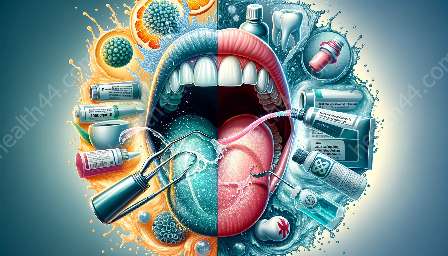When it comes to maintaining oral hygiene, chlorhexidine mouthwash plays a vital role in killing bacteria and preventing oral infections. Understanding the mechanism of action behind this mouthwash can help you appreciate its benefits and make informed choices about oral care.
Understanding the Need for Effective Mouthwash
Oral hygiene is crucial in maintaining a healthy mouth and preventing dental problems. While regular brushing and flossing are essential, they may not always reach all areas of the mouth or eliminate all harmful bacteria. This is where mouthwashes, such as chlorhexidine, come into play to provide additional protection.
The Role of Chlorhexidine Mouthwash in Killing Bacteria
Chlorhexidine is a chemical compound known for its broad-spectrum antimicrobial properties. When used as a mouthwash, chlorhexidine exerts its bactericidal effect by disrupting bacterial cell walls and interfering with essential cellular functions. This results in the death of a wide range of bacteria, including those responsible for gum disease, dental plaque, and bad breath.
Upon rinsing with chlorhexidine mouthwash, the active ingredient binds to oral tissues and forms a protective layer that continues to release antimicrobial agents, effectively killing bacteria for an extended period.
The Mechanism of Action
Chlorhexidine works by targeting the negatively charged bacterial cell membranes. It disrupts the osmotic equilibrium within the bacterial cell, leading to leakage of essential cellular components and eventual cell death. Furthermore, chlorhexidine can interfere with bacterial enzyme systems, impairing their ability to function and replicate.
Benefits of Chlorhexidine Mouthwash
- Broad-spectrum Protection: Chlorhexidine mouthwash effectively targets a wide range of bacteria, providing comprehensive protection against oral infections.
- Long-lasting Effect: The residual antimicrobial action of chlorhexidine continues to work after rinsing, offering prolonged defense against bacteria.
- Plaque Control: Regular use of chlorhexidine mouthwash can help reduce the formation of dental plaque and tartar, promoting healthier teeth and gums.
- Gum Disease Prevention: By eliminating bacteria responsible for gum disease, chlorhexidine contributes to the prevention and management of periodontal issues.
- Halitosis Management: The antibacterial properties of chlorhexidine aid in controlling bad breath by targeting odor-causing bacteria in the mouth.
Best Practices for Using Chlorhexidine Mouthwash
It is important to use chlorhexidine mouthwash as directed by your dentist or healthcare professional. While it provides numerous benefits, prolonged or excessive use can lead to side effects such as tooth staining and altered taste perception. By following recommended guidelines, you can maximize the advantages of chlorhexidine mouthwash while minimizing potential adverse effects.
Conclusion
In conclusion, chlorhexidine mouthwash is a valuable addition to oral hygiene routines, offering effective bacterial control and long-lasting protection. Understanding its mechanism of action and benefits can empower individuals to make informed decisions about their oral care, leading to improved overall dental health.









